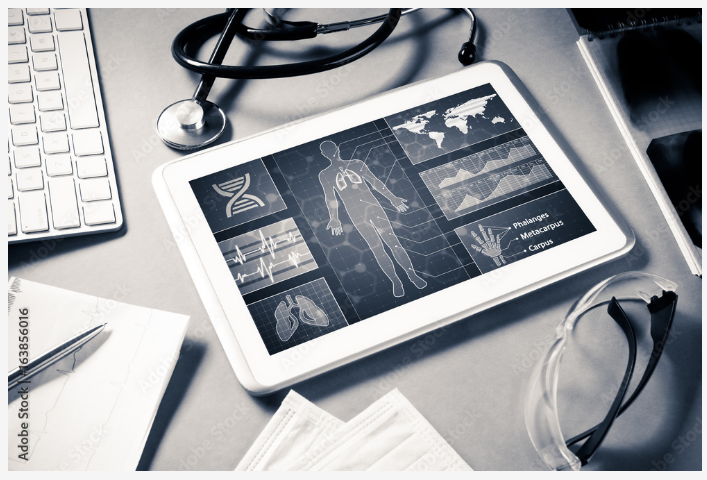There is no denying the fact that healthcare and medicine are an integral part of all of our lives. With the pandemic of covid 19, the importance and the lagging of the technological innovations in healthcare were made strikingly evident. However, that proved to be the beginning of a new era of technological innovations in healthcare. Some of the fast-growing healthcare technology trends worldwide happen to involve telemedicine, personalized medicine, wearables, and genomics.
The very reason that potent covid 19 vaccinations could be produced quickly was thanks to the advancements in genomics and informatics. Further, the use of Artificial Intelligence (AI) and Machine Learning (ML) helped improvise the probable vaccines and their effect or potency on the virus.
The use of technology in healthcare has taken a new turn. It is developing new scenarios which are not only convenient but also more competent, to begin with. Some of the major healthcare technology trends to look out for this year have been compiled in this blog. Read on for more information.
- 1) Virtual care for enhanced reach
Apps for online consultation – Online consultation has been taken up by half of the world population as per recent surveys, thanks to the situation led by the covid 19 pandemic. In most cases, hospitals are offering specialized applications which are holistic in nature, providing patients with a comprehensive range of options such as – online consultation, prescription, medications, pathology, diagnostics, etc. With reduced logistics and hassle, this concept has been wholeheartedly welcomed by people around the world. Reports suggest that as much as 64% or more companies involved in healthcare are investing to develop a virtual healthcare infrastructure.
Chatbots to reduce nurse loads – AI-powered chatbots help understand the symptoms of the patients and pass on the relevant information to the doctors before the consultation begins. It has helped free up the redundant tasks of the nurses, thereby freeing them up for putting their effort and energy elsewhere. Also termed as Robotic Process Automation or RPA, these help by improving healthcare processes through automation and improving professionals’ performance by more than 30%. Some of the tasks that fall under the premise of RPA are data management for patient information, scheduling patient appointments, accelerating data processing, and improved efficiency.
Automated Ordering diagnostics and medicines – Understanding badly written prescriptions is a thing of the past. Applications and algorithms now help you order the medicines prescribed by your healthcare consultant (through online consultation) on the online platform directly from associated pharmacies. Further, the tests prescribed too can be ordered online, while a healthcare professional can reach your residence to perform the requisite tests. Long gone are the days of standing in long queues and long waiting times. Convenience is the keyword in 2022 when it comes to key healthcare technology trends.
Virtual ER – Consulting with patients through devices such as iPad or smartphones, doctors are now equipped to provide consultation to remote places. It is quite beneficial, especially in cases such as the recent Covid 19, where the infectiousness of the disease posed a threat to caretakers and doctors. Even when such communicable diseases are out of the scene, the functionality of remote virtual ER is undeniable. In places where the number of doctors is less proportionate to the population such as India and China, virtual ER brings about a ray of hope to the patients in need.
Better resource allocation — Another benefit of the same is that panic calls that are not an emergency can be taken care of through virtual ER, leaving the hospital ER wards free to take care of those who need emergency support. Further, automated processes have eased the load of data processing on healthcare professionals. Thus, this talent pool that was unavailable till now owing to redundant processes is now free to work for the patient’s welfare.
- 2) AI-powered processes and Predictions for Better management
AI-enabled healthcare – While research work has been going on in the field of AI-enabled healthcare procedures such as minor operations or minimally invasive procedures, recent years have seen more hospitals and medical practitioners adopting this technology. AI-powered robotic hands and machines are more precise, with minimal scope of mistakes, thereby increasing efficiency. Further, diagnostics such as involving radiology can easily be handled and reported by AI-enabled bots even as imaging technicians and professionals can guide remotely. It saves the professionals a lot of energy and time to spend where it matters more, even as bots take over to perform such repetitive tasks.
Technology-enabled health services — Virtual Reality or VR is also being used for treatment purposes. Children with autism or other such illnesses are being treated with VR for better social skill development. Further, people suffering from cognitive illnesses such as schizophrenia, etc are also being given CBT or Cognitive Behavioural Therapy using Virtual Reality to help patients overcome their fears and phobias.
AI for repetitive, redundant tasks – Artificial Intelligence is slotted to take over the redundant tasks like scheduling appointments, taking patient history, etc. It will free the nurses in charge of these processes, thereby enabling them to better utilize their talent and services.
AI for predictions – The AI algorithms have advanced and are now being used to predict the rate of spread of pandemics or epidemics. The AI-enabled healthcare systems are also adept at identifying the physical statistics of large groups of people. It has enabled healthcare in several countries to monitor the rate of infections, people requiring immediate medical aid, etc. Connected cameras and ML computers have brought healthcare to every doorstep, ushering in better and fast responses from healthcare professionals.
- 3) Better improved talent pool due to remote collaborations
Remote training for better performances – Healthcare professionals and hospitals are now collaborating to train professionals remotely. Not only does this enhance the overall talent pool available, but it also reduces the total cost of training. The remote training and functioning have offered the patients a chance to get better healthcare services. With an expert supervising from a faraway location, trainees or subordinates can perform critical procedures with ease and perfection.
Augmented Reality (AR) for Training – With Augmented Reality coming in big time, the quality of training has also significantly improved. AR enables students and trainees to get hands-on experience in conducting procedures, without the risk to the patient. AR also allows the users to understand the scope of improvement and repeat practice sessions, making the training process more effective. Surveys indicate that as much as 35% of training institutes and colleges are already adapting to AR and VR technologies (a combination of which is termed extended reality (XR)) to enhance the overall training experience. The year 2022 is bound to see a rise in this percentage.
Remote access and operations by talent pool – With the advent of robotic surgeries and camera-assisted surgeries, the scope of remote access to these devices by doctors has distinctly increased. Therefore, for specialist doctors to conduct high-risk surgeries at different locations has become a possibility with remote ER and OT systems.
Worldwide access to the best services due to remote collaborations – The earlier dearth of competitive services at all corners of the world posed a threat to critical patients and their care. However, with virtual care and remote collaborations, patients worldwide can get the best healthcare opinions from the best doctors irrespective of the location. It has improved the overall quality of healthcare systems, thereby increasing the chances of survival of critical patients. For instance, ultrasonography performed elsewhere can be shared live with an expert healthcare professional sitting in any corner of the world. Thus, virtual collaborations have increased the chances of patients getting the best consultation and treatments.
- 4) Enhanced Data pool for innovations and developments
Usher Innovation — Data is the king, and this holds true in every field looking for innovation and creation. Healthcare is one of the industries that has undergone a massive transformation since the pandemic struck. In such a scenario, big data is the need of the hour to bring about innovations, and understand what the consumers need. The pandemic brought forth the need for remote monitoring and consultation to minimize physical interaction between people. The same was intercepted, and applications developed where teleconsultation and reports sharing were made easy. The next few months saw the need for remote or mobile ICU. Healthcare companies understood the requirement and developed solutions that provided the customers with the same. Several lives have been saved due to this innovation, especially when there was a shortfall of ER availability.
Analyzing Health Data — What needs to be understood is that with most of the healthcare data online now — starting from HER (Electronic Health Records) to IoT devices (fitness trackers, heart rate monitors, etc) and diagnostics reports — the need for assessing and analyzing this data is evermore. When this data is used properly, it will help identify the risks that a person faces in terms of health, thereby allowing for a timely intervention to reduce the chances of critical conditions later.
Identifying Consumer need to Build on new Products — Further, it is not wrong to say that healthcare companies looking for innovation and new product offerings can easily use this big data to understand their consumers better and their needs. With reports and medical data of the consumers available online, research companies can work on developing better technological advancements in the field of medicine.
- 5) Integrated diagnostics and patient-care for improved critical care
Remote Patient Monitoring and Digital Therapeutics — Critical care has transformed with mobile ICU and AI-powered critical care units. Regular monitoring of the body statistics by AI reduces the chances of missing out on new crucial developments. It helps in identifying risks and providing timely interventions to prevent serious implications. The concept of digital therapeutics, though new, is gaining traction in the healthcare world. Digital Therapeutics is where AI-enabled systems determine and deliver the medications, right dose at the right time to the patients, monitor blood sugar and pressure levels, and initiate exercise if required by the patients.
- 6) Ushering Energy Efficient Technology
SaaS (Software as a Service) Models for increased efficiency — SaaS helps in remote collaborations as doctors, staff, and patients can all access information online. It is Cost-effective and enables the hospitals and management financial flexibility. The SaaS model is also energy efficient. On average, using SaaS models for management purposes has seen an increase in server utilization by 65%. Thus, it requires fewer servers when the cloud is used for data processing, thereby reducing carbon emissions and waste. The Healthcare industry attributes 4% of the global carbon emissions. Transitioning to SaaS models is the key to reducing this carbon footprint. Today, efficiency is the key to growth, and reducing the financial burden is essential without compromising the quality of services provided to the patients. Adopting SaaS models, therefore, is the best solution for the same.
Renewable Energy Consumption – Needless to say, when discussing energy efficiency, no discussion remains complete without focussing on the need to use renewable energy sources. From designing green buildings and hospitals to using clean energy to power the hospital operations and machines, this concept is catching up fast. The need to collaborate with green developers has increased over the years and the year 2022 is bound to see a rise in this healthcare technology trend.
Follow and like us on LinkedIn,Twitter and Facebook &Instagram.





Comments are closed.